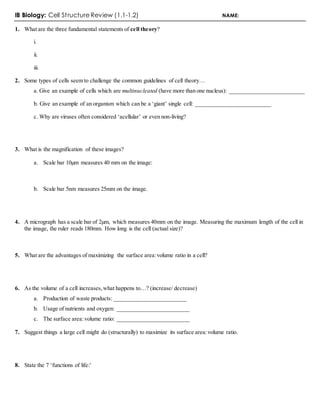
IB Cell Structure Review (1.1-1.2)
- 1. IB Biology: Cell Structure Review (1.1-1.2) NAME: 1. What are the three fundamental statements of cell theory? i. ii. iii. 2. Some types of cells seem to challenge the common guidelines of cell theory… a. Give an example of cells which are multinucleated (have more than one nucleus): __________________________ b. Give an example of an organism which can be a ‘giant’ single cell: __________________________ c. Why are viruses often considered ‘acellular’ or even non-living? 3. What is the magnification of these images? a. Scale bar 10µm measures 40 mm on the image: b. Scale bar 5nm measures 25mm on the image. 4. A micrograph has a scale bar of 2µm, which measures 40mm on the image. Measuring the maximum length of the cell in the image, the ruler reads 180mm. How long is the cell (actual size)? 5. What are the advantages of maximizing the surface area:volume ratio in a cell? 6. As the volume of a cell increases,what happens to…? (increase/ decrease) a. Production of waste products: _________________________ b. Usage of nutrients and oxygen: _________________________ c. The surface area:volume ratio: _________________________ 7. Suggest things a large cell might do (structurally) to maximize its surface area:volume ratio. 8. State the 7 ‘functions of life:’
- 2. 9. Describe what is meant by the term emergent properties and how they relate to cells. 10. This is an electron micrograph of the bacterium Salmonella typhi. a. What is the magnification of this image? b. What is the maximum (actual) length of the main body of the cell? c. What is the name and function of this structure? d. S. typhi and E. coli are examples of prokaryotes. What does the term ‘prokaryote’ mean? 11. In the space below, draw and label (with names and functions),the structure of a generalized prokaryote cell. Include capsule, cell wall, plasma membrane, pili, flagella, nucleoid (naked DNA), cytoplasm, and ribosomes (70s). 12. In the table below, complete the comparison between prokaryote and eukaryote cells: Prokaryote Eukaryote 70S Ribosomes Nucleus contains DNA DNA associated with protein No mitochondria, Golgi, or ER Circular DNA Reproduces by binary fission Contains membrane-bound organelles 10-100 micrometers 13. This image is a transmission electron micrograph of a bacterium. a. Identify the labeled structures I……………………………… II…………………………….. III……………………………. IV……………………………. b. Calculate the magnification of the image:
- 3. 14. The image below shows a TEM micrograph of a liver cell. a. Identify the labeled structures: cell membrane, nuclear membrane, nucleus, mitochondria, Endoplasmic reticulum b. Calculate the magnification of the image, right: c. Calculate the maximum (actual) diameter of the nucleus: 15. Outline the functions of these eukaryotic organelles: Organelle Structure (description) Function of organelle Region of the cell containing chromosomes, surrounded by a double membrane, in which there are pores. Storage and protection of genetic information on chromosomes. Ribosome Small spherical subunit consisting oftwo subunits,some attached to membranes, others free. Spherical organelles surrounded by a single membrane, containing digestive enzymes. Digestion of structures and molecules that are not needed in the cell. Organelles surrounded by two membranes, the inner of which is folded inwards. Chloroplast Double-membrane containing layers of membranes (thylakoid stacks) and the pigment chlorophyll. Large, folding membrane structure found close to the nucleus, with ribosomes attached to some surfaces. Golgi Apparatus Large, folded membrane structure found close to the plasma membrane, often with vesicles budding off the outer edge. 16. State at least three differences between plant and animal cells. 17. Explain how cells of multicellular organisms differentiate from stem cells to become specialized cells.
